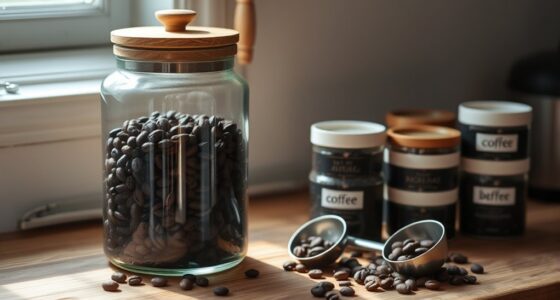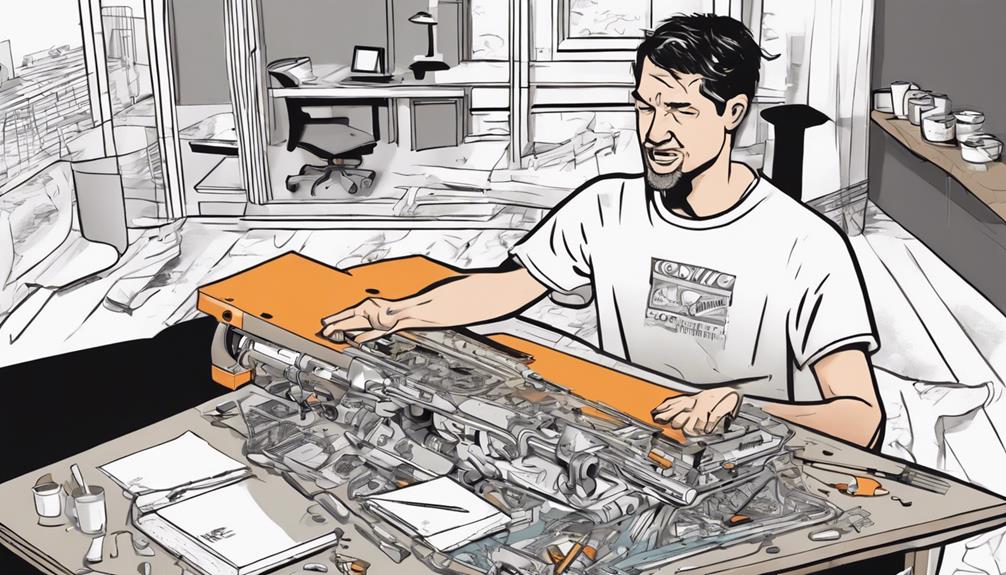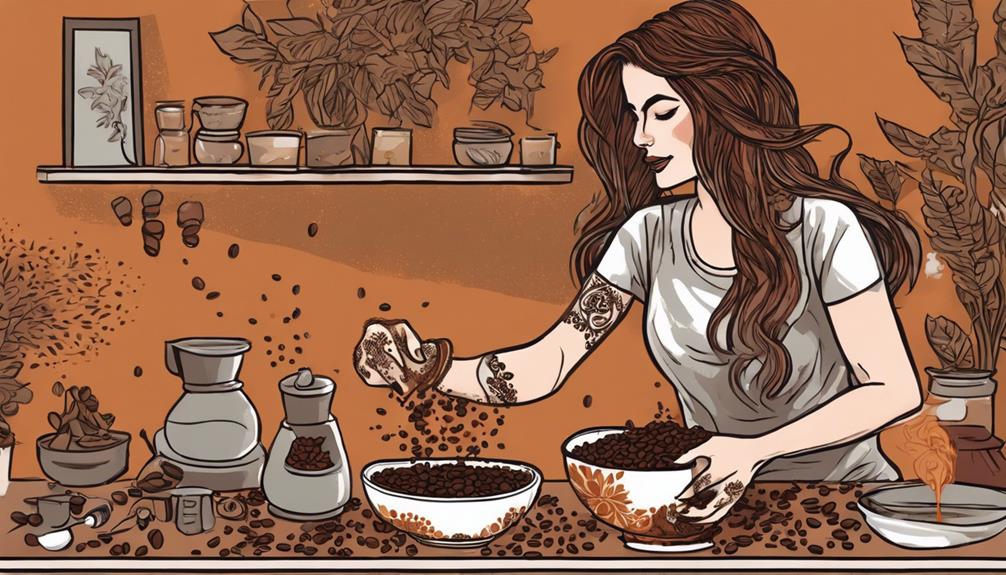To prepare the perfect Aeropress coffee using Aeropress Ace, begin by grinding coffee beans finely. Warm water to 175-185°F and moisten a filter in the Aeropress cap. Add the grounds, pour the water, stir, and insert the plunger. After 1-2 minutes, press down on the plunger. Make adjustments to the grind size, amount of coffee used, and ratio to achieve customized flavors. Test out various blends and filters for distinct tastes. Explore other brewing techniques such as French press or pour-over. Discover the optimal balance for a delightful cup of coffee.
Key Takeaways
- Use fine grind and water at 175-185°F.
- Pre-wet filter, add grounds, pour water, stir.
- Plunge after 1-2 minutes for 1-3 cups.
- Customize grind, dose, and ratio for taste.
- Experiment with filter choice for desired characteristics.
Brewing Essentials
To brew perfect Aeropress coffee, understanding the brewing essentials is essential for achieving the best results. The Aeropress Ace brewing method combines pressure and immersion, creating a rich coffee experience that stands out. To brew using the Aeropress Ace method, start by ensuring your coffee grounds are at the correct coarseness and using the right water temperature. Then, follow the Aeropress instructions to press the coffee through the filter. For an extra creamy texture, consider beating coffee with hand blender for a few seconds after brewing. This adds an extra level of richness to the coffee experience.
This unique brewing process is rapid, yielding 1 to 3 cups of coffee in about a minute. One key element of this method is the use of a micro-filter, ensuring that your coffee is free of any grit, resulting in a smooth and enjoyable cup every time.
Aeropress Ace is renowned for producing coffee with less bitterness and acidity compared to other brewing methods, making it a favorite among coffee enthusiasts. Whether you're at home or out camping, this lightweight and easy-to-clean brewing device is versatile and convenient for all settings.
Mastering the brewing essentials of the Aeropress Ace is the first step towards enjoying a consistently delicious cup of coffee.
Step-by-Step Guide

Understanding the brewing essentials sets the stage for mastering the step-by-step process of creating a delicious Aeropress espresso.
To begin, grind your coffee beans to a fine consistency, similar to table salt. Heat water to around 175-185°F, ensuring it's not boiling. Insert a paper or metal filter into the Aeropress cap and pre-wet it to remove any paper taste or residue.
Next, add the coffee grounds to the Aeropress chamber, followed by pouring the hot water up to the desired level. Give the mixture a quick stir for even saturation and place the plunger on top.
After a short brew time of about 1-2 minutes, slowly press down on the plunger with steady pressure.
Personalizing Your Coffee

Adjusting the grind size of your coffee beans can have a significant impact on the body and texture of your Aeropress espresso. Finer grinds result in a smoother texture, while coarser grinds may offer a bolder taste.
By changing the coffee dose, you can tailor the strength of your brewing to suit your preferences, ensuring a personalized coffee experience. Experimenting with the coffee-to-water ratio is another way to fine-tune your cup, allowing you to achieve the desired strength and flavor profile.
Additionally, selecting different coffee blends such as House Filter, Classic Espresso, or Decaf Filter can cater to a variety of taste preferences, further enhancing your brewing experience.
To conclude, the choice of filter, whether paper or metal, plays an important role in shaping the taste and characteristics of your Aeropress espresso. Personalizing these elements will help you create a cup of coffee that truly satisfies your unique palate.
Coffee Varieties for AeroPress

When selecting coffee varieties for your AeroPress, consider the impact the filter has on taste, the brewing time required, and the aroma differences noted in each blend.
Different blends cater to various taste preferences, offering unique flavor profiles like butterscotch, dark chocolate, and more.
Tailored AeroPress coffee varieties aim to bring out distinct aromas and flavors in every cup you brew.
Filter Impact on Taste
Consider using paper filters in your Aeropress for a clean cup with a pronounced acidity or opt for metal filters to produce a heavier cup with a rich aroma and lower acidity. Paper filters are excellent for those who enjoy a brighter and cleaner taste profile, as they filter out fine coffee particles, resulting in a smoother texture and accentuated acidity. On the other hand, metal filters allow more oils and micro-grounds to pass through, giving your coffee a fuller body and a more espresso-like experience with a richer aroma and decreased acidity.
| Filter Type | Taste Profile |
|---|---|
| Paper | Clean, pronounced acidity, less body |
| Metal | Heavy, rich aroma, lower acidity |
Brewing Time Influence
Understanding how different coffee varieties interact with varying brewing times is important for achieving the perfect cup of AeroPress coffee. The brewing time plays a vital role in extracting the desired flavors from your chosen coffee beans.
Lighter roasts, known for their delicate and nuanced flavors, generally require shorter brewing times to prevent bitterness and over-extraction. On the other hand, darker roasts, with their bold and robust profiles, may benefit from longer brewing times to enhance their rich flavors.
Experimenting with brewing times allows you to fine-tune the taste profile of your AeroPress coffee to match your preferences perfectly. By adjusting the brewing time based on the coffee variety you're using, you can create a personalized and enjoyable brewing experience.
Aroma Differences Noted
Various coffee varieties specifically crafted for AeroPress brewing showcase distinct aroma differences that contribute to the overall flavor experience. When selecting your beans, consider the following aroma notes to enhance your brewing adventure:
- House Filter coffee: Delight in the fragrant hints of butterscotch, raisin, and walnut that will fill your senses as you prepare your AeroPress cup.
- Classic Espresso blend: Experience the rich aromas of malt, dark chocolate, and walnuts that will add depth to your coffee ritual.
- Decaf Filter coffee: Indulge in the comforting scents of milk chocolate, peanut, and raisin that will create a cozy atmosphere as you savor your delectable brew.
Each aroma profile offers a unique olfactory journey, enriching the overall sensory experience of your AeroPress coffee. By exploring these distinct aromas, you can elevate your brewing routine and discover new dimensions of flavor in every cup.
Alternative Brewing Methods

When exploring alternative brewing methods for coffee, you encounter a diverse range of techniques that offer unique ways to extract flavors from coffee beans. Some popular methods include AeroPress, French press, pour-over, and cold brew.
The AeroPress stands out for its versatility, allowing you to brew both espresso-style shots and filter-style coffee, making it a favorite among coffee enthusiasts. On the other hand, the French press delivers a full-bodied brew with a rich taste and texture, perfect for those who enjoy a robust cup of coffee.
If you prefer a more delicate and nuanced flavor profile, the pour-over method might be your best choice. Pour-over brewing emphasizes clarity and complexity in coffee flavors through a slow extraction process that brings out the subtleties of the beans.
Each method offers a unique experience, catering to different preferences and showcasing the diversity of the coffee brewing world.
Coffee Brewing Ratios

To brew perfect Aeropress coffee, the coffee-to-water ratio is an essential factor that greatly influences the strength and flavor of your final cup.
When aiming for that ideal cup of AeroPress coffee, consider the following:
- The standard AeroPress coffee-to-water ratio is 1:16, but alternative recipes suggest ratios of 1:12–1:16 for different strengths.
- Adjusting the grind size affects the body of the coffee, with a super fine grind recommended by AeroPress for best results.
- Brew times for AeroPress coffee typically range from 2-3 minutes, with finer grinds requiring shorter brew times for optimal results.
Grinding Techniques

When grinding coffee for your Aeropress, the size of the grind plays an essential role in the flavor of your brew.
Finer grinds create a bolder taste, while coarser grinds offer a milder experience.
Consistency in grind size is key to achieving a well-balanced extraction in your Aeropress coffee.
Grind Size Importance
Have you ever wondered why the grind size is so essential when brewing Aeropress coffee?
The grind size plays a pivotal role in determining the flavor, body, and overall quality of your coffee. Here are some key points to keep in mind:
- Intensity and Extraction Speed: A finer grind size, similar to table salt, intensifies the flavor and accelerates the extraction process, resulting in a bolder cup of coffee.
- Impact on Body, Clarity, and Sweetness: Adjusting the grind size can affect the body, clarity, and sweetness of your Aeropress coffee, allowing you to tailor the brew to your preferences.
- Consistency for Even Extraction: Consistency in grind size is essential for ensuring uniform extraction and a well-balanced flavor profile in every cup of Aeropress coffee you brew.
Experimenting with different grind sizes not only lets you customize your coffee but also helps you discover the perfect balance for a delightful Aeropress experience.
Filter Choice Impact
The choice of filter in your AeroPress greatly influences the flavor profile of your coffee, especially when considering different grinding techniques. Using paper filters results in a clean cup with distinct acidity, perfect for bringing out fruity or floral coffee notes.
On the other hand, metal filters create a heavier brew with a rich aroma and lower acidity, enhancing the body and mouthfeel of the coffee. Paper filters, by filtering out coffee particles, provide a smoother brew with less sediment and a cleaner taste profile.
Conversely, metal filters allow micro-grounds and oils to pass through, yielding a shot more akin to espresso, with a fuller body and intensified flavor. Both filter types can work well with the AeroPress recipe, but metal filters closely mirror the characteristics of true espresso shots.
Whether you opt for paper or metal filters, using filtered water is essential to guarantee the best extraction and flavor in your AeroPress coffee.
Perfecting AeroPress Espresso

To master the art of perfecting AeroPress espresso, focus on achieving the ideal grind size and water temperature for a flavorful and aromatic brew. When making coffee with an AeroPress, keep these key points in mind:
- Use a fine grind: Opt for a fine grind similar to table salt to ensure proper extraction and a robust flavor profile.
- Maintain water temperature: Heat water to 195°F for peak brewing conditions that bring out the best in your coffee grounds.
- Time your plunge: Aim for a 30-second plunge to extract the right amount of flavor without over-extraction.
With these considerations in mind, you can create a balanced and concentrated AeroPress espresso that rivals the richness of true espresso machines.
Experiment with different grind sizes, water temperatures, and plunge times to fine-tune your brewing process and enjoy a delicious cup of AeroPress espresso at home.
Frequently Asked Questions
How Do I Get the Best Results From Aeropress?
To get the best results from Aeropress, use a fine grind for optimum extraction. Experiment with water temperature for a perfect balance. Choose paper or metal filters to customize body and acidity. Shake before plunging and press for 25-30 seconds for a balanced brew.
How to Make the Best Cup of Coffee With Aeropress?
To make the best cup of coffee with Aeropress, grind coffee finely, pour water slowly, and plunge at precise timings. Experiment with different filters like paper for acidity or metal for richness to enhance your coffee experience.
What Is the Best Ratio for Aeropress Coffee?
For the best Aeropress coffee, aim for a 1:16 coffee-to-water ratio. But hey, you can play around! Some go 1:6 for that espresso kick. Adjusting ratios tunes flavor. Find your sweet spot!
How Many Scoops of Coffee Do You Put in an Aeropress?
For your Aeropress, put 1-2 scoops of coffee, about 12-14g. Adjust for taste. Use a digital scale for accuracy. Experiment with ratios for your perfect brew. The Aeropress scoop simplifies measuring.
Conclusion
So there you have it – with the AeroPress Ace, brewing the perfect cup of coffee is within your reach!
Experiment with different brewing techniques, grind sizes, and coffee varieties to find your perfect cup. Just like a skilled artist with their brush, you can craft a delicious masterpiece with every press.
So go ahead, awaken your inner barista and enjoy the rich, flavorful results of your AeroPress brewing skills. Cheers to great coffee!









